Chiffon velvet offers a lighter, more breathable alternative to traditional velvet, making it ideal for warmer climates or clothing with delicate drape requirements. Unlike traditional velvet, which features a dense, plush pile, chiffon velvet combines the softness of velvet with the sheer texture of chiffon, adding a subtle elegance and fluidity to garments. This blend of textures enhances versatility, allowing chiffon velvet to be used in both casual and formal wear, while traditional velvet remains favored for its rich, luxurious appearance and heavier weight.
Table of Comparison
| Feature | Chiffon Velvet | Traditional Velvet |
|---|---|---|
| Texture | Lightweight, sheer, soft | Dense, plush, heavy |
| Appearance | Delicate, translucent, elegant | Rich, deep pile, luxurious |
| Use | Eveningwear, scarves, overlays | Upholstery, drapery, formal garments |
| Durability | Moderate, delicate handling needed | High, strong and long-lasting |
| Maintenance | Requires gentle cleaning | Can withstand regular cleaning |
| Cost | Generally higher-priced due to delicate nature | Varies; often affordable and widely available |
Understanding Chiffon Velvet: Key Characteristics
Chiffon velvet features a lightweight, sheer texture that differentiates it from traditional velvet's dense pile and heavy feel. Its delicate weave creates a soft, flowing drape ideal for elegant garments and decorative accents. The fabric combines the luxurious sheen of velvet with the airy quality of chiffon, making it a versatile choice for fashion and design applications.
What Defines Traditional Velvet?
Traditional velvet is defined by its dense pile created from woven silk or cotton threads, resulting in a luxurious, soft texture with a rich sheen. Its intricate weaving process produces a fabric known for durability and a distinctive nap that changes color depending on the light or angle. Often heavier and thicker than chiffon velvet, traditional velvet is commonly used in upholstery, drapery, and formal apparel.
Differences in Fabric Construction
Chiffon velvet features a lightweight, sheer construction with delicate pile, created by weaving chiffon yarns with velvet textures, resulting in a soft, translucent fabric ideal for elegant drapes and clothing. Traditional velvet is woven with a dense, cut pile on a heavier base fabric, providing a plush, luxurious feel and rich texture commonly used in upholstery and formal attire. The key difference lies in chiffon velvet's fine, airy weave compared to traditional velvet's thick, heavy weave, affecting drape, weight, and opacity properties.
Texture and Appearance Comparison
Chiffon velvet features a lighter, more delicate texture with a semi-sheer quality that allows for greater drape and fluidity compared to traditional velvet. Traditional velvet boasts a dense, plush pile and rich, luxurious appearance with deep color saturation and a soft, velvety hand feel. The unique weave of chiffon velvet creates a subtle, shimmering finish, while traditional velvet emphasizes a thicker, matte surface ideal for upholstery and heavy garments.
Durability and Longevity
Chiffon velvet, made with a lighter weave and finer fibers, offers a more delicate texture but tends to be less durable than traditional velvet, which features a denser pile and robust fiber construction. Traditional velvet's tightly woven base and thick pile provide superior resistance to wear, abrasion, and fading, making it ideal for high-traffic upholstery and long-lasting use. Durability and longevity in traditional velvet outperform chiffon velvet, especially in applications demanding heavy usage and sustained aesthetic appeal.
Best Uses for Chiffon Velvet
Chiffon velvet offers a lightweight, flowing texture that makes it ideal for elegant evening wear and delicate drapery, where softness and subtle sheen are desired. Traditional velvet, being thicker and denser, suits upholstery and heavy winter garments that require durability and warmth. Use chiffon velvet for garments that demand fluid movement and a luxurious feel without the weight of conventional velvet fabrics.
Ideal Applications of Traditional Velvet
Traditional velvet, known for its dense pile and luxurious texture, is ideal for upholstery, drapery, and formal garments due to its durability and classic appearance. Its rich sheen and weight make it perfect for high-end furniture coverings, evening wear, and theatrical costumes where opulence is desired. The fabric's robust construction withstands heavy use, making it suitable for interiors requiring both elegance and strength.
Maintenance and Care Tips
Chiffon velvet requires more delicate maintenance than traditional velvet due to its lightweight and sheer fabric, necessitating gentle hand washing or dry cleaning to preserve its texture. Traditional velvet can often withstand machine washing on a gentle cycle but still benefits from professional cleaning to maintain its plush pile and prevent matting. Both materials should be stored away from direct sunlight and moisture to avoid fading and fabric damage, with chiffon velvet demanding extra caution to prevent snagging and tearing.
Price and Accessibility Differences
Chiffon velvet typically costs less than traditional velvet due to its lighter weight and simpler weaving process, making it more accessible for budget-conscious buyers. Traditional velvet, often made from silk or heavy cotton, carries a higher price point reflecting its luxurious texture and durability. While chiffon velvet is widely available in various retail outlets, traditional velvet remains more exclusive, often found in specialty fabric stores or high-end boutiques.
How to Choose Between Chiffon Velvet and Traditional Velvet
Chiffon velvet offers a lightweight, more breathable texture ideal for summer garments, while traditional velvet provides a heavier, plush feel suited for winter wear and upholstery. Selecting between chiffon velvet and traditional velvet depends on the specific application, desired comfort level, and seasonal suitability. Consider fabric weight, drape, and durability to match the intended use, ensuring an optimal blend of style and function.
Chiffon Velvet vs Traditional Velvet Infographic

 materialdif.com
materialdif.com